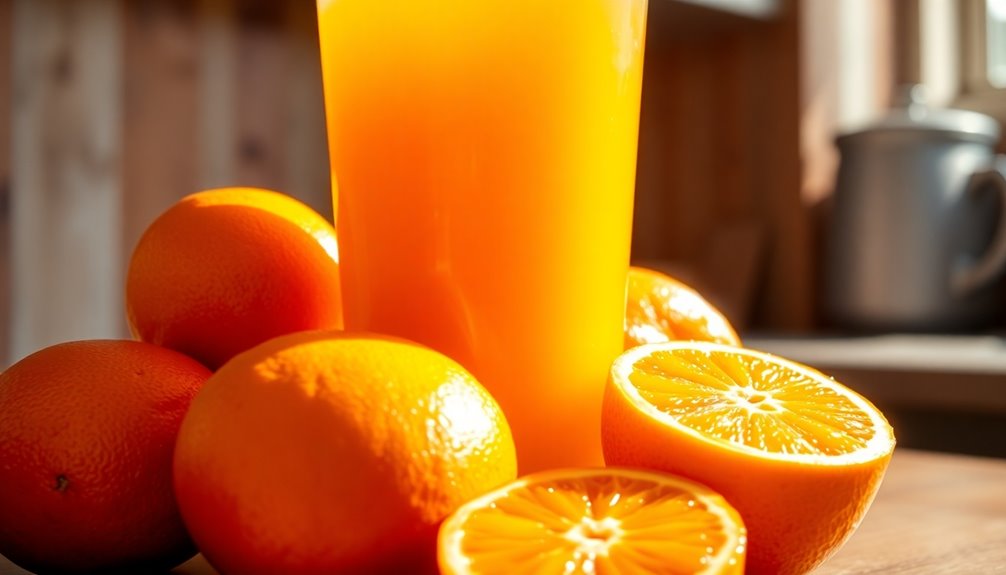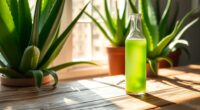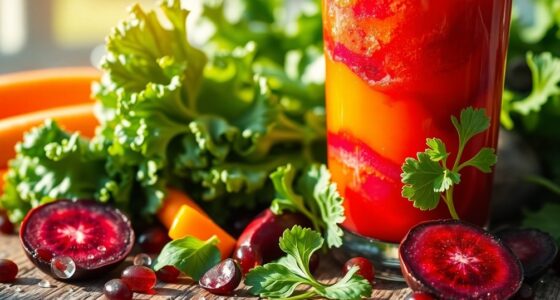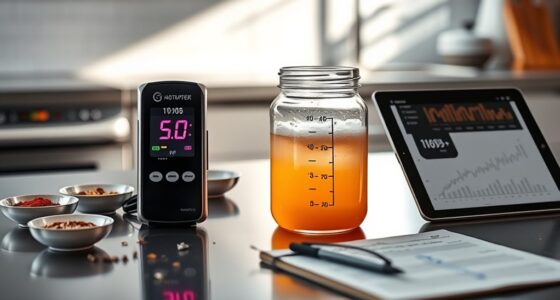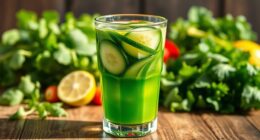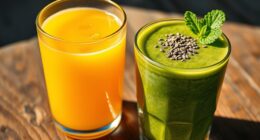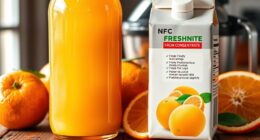To make a glass of orange juice, you usually need about three medium-sized oranges. This can vary based on the orange variety and their juiciness. Valencia oranges tend to work best for juicing, but other types can also yield tasty results. If you're looking to maximize your juice production or want to know how to adjust based on different oranges, you'll find some helpful tips and tricks.
Key Takeaways
- A medium-sized orange typically yields about 2.67 ounces of juice, so around three oranges are needed for a standard 8-ounce glass.
- Average juice yield from an orange is about 56%, but this can vary by size and type.
- Valencia oranges are preferred for juicing due to their high juice content and sweetness.
- Using ripe and high-quality oranges will enhance juice extraction and overall yield.
- Different juicing methods, such as masticating juicers, can significantly improve juice yield from oranges.
The Juice Yield of a Single Orange
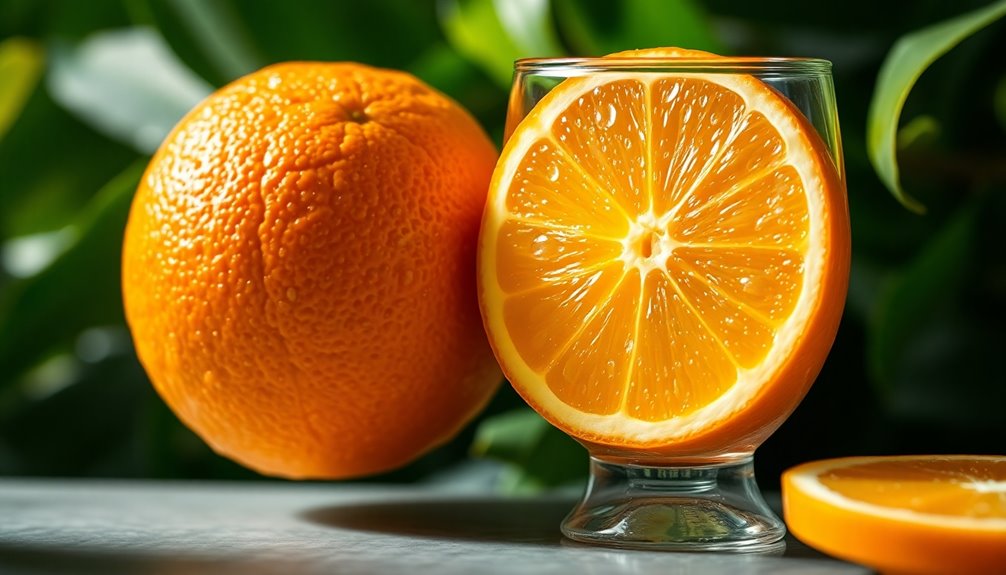
When you squeeze an orange for juice, understanding its juice yield is essential. The average yield from an orange is about 56%, but this can vary based on size and type. To calculate the yield, weigh the orange before and after juicing, then find the percentage of juice extracted. For example, a 222g orange might yield around 53.6%. Generally, average-sized oranges provide more consistent yields, while smaller ones tend to produce less juice. Interestingly, larger oranges may have lower yields due to thicker skins. Ultimately, knowing the juice yield helps you maximize your efforts and manage costs effectively, ensuring you get the most juice from every orange you squeeze. Freshly squeezed juice is often preferred for its taste over bottled alternatives, further emphasizing the importance of understanding juice yields. Additionally, considering the nutritional advantages of the juice can enhance your appreciation for the effort put into juicing.
Factors Affecting Juice Quantity
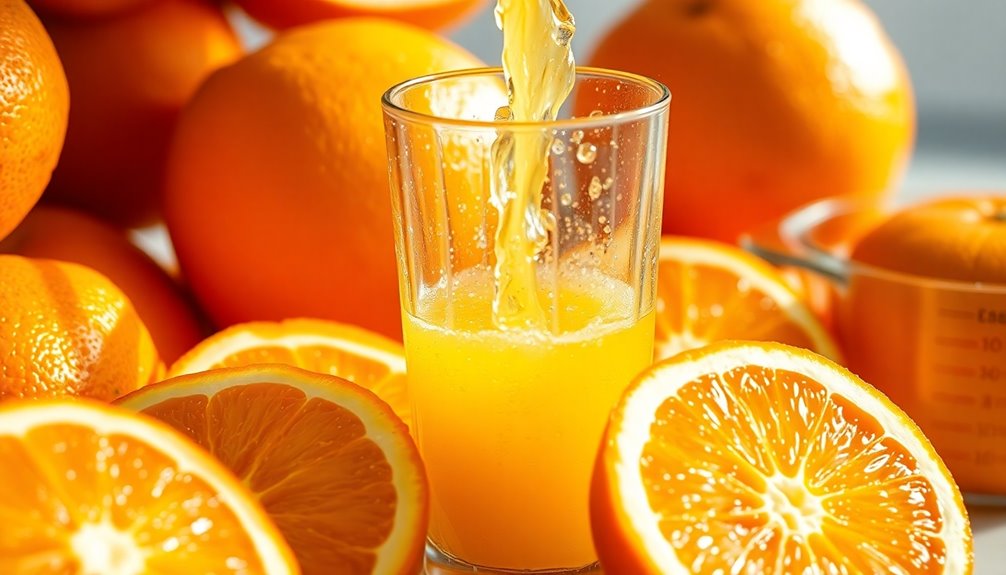
After understanding the juice yield of a single orange, it's important to consider the various factors that can influence the overall quantity of juice you'll get.
First, the quality of your oranges matters; fresh, ripe, and undamaged fruits yield better juice.
Next, the juice extraction method you choose can significantly affect the yield. Specialized extractors are often necessary for different fruits.
Additionally, sterilization processes impact shelf life and quality, with sterilization temperature and time playing key roles. Proper filling technologies also preserve nutritional content.
Lastly, maintaining high-quality equipment and sanitation practices ensures a contamination-free environment, while careful handling during harvesting, storage, and transportation helps maintain the fruits' freshness, maximizing your juice quantity.
Different Types of Oranges for Juicing
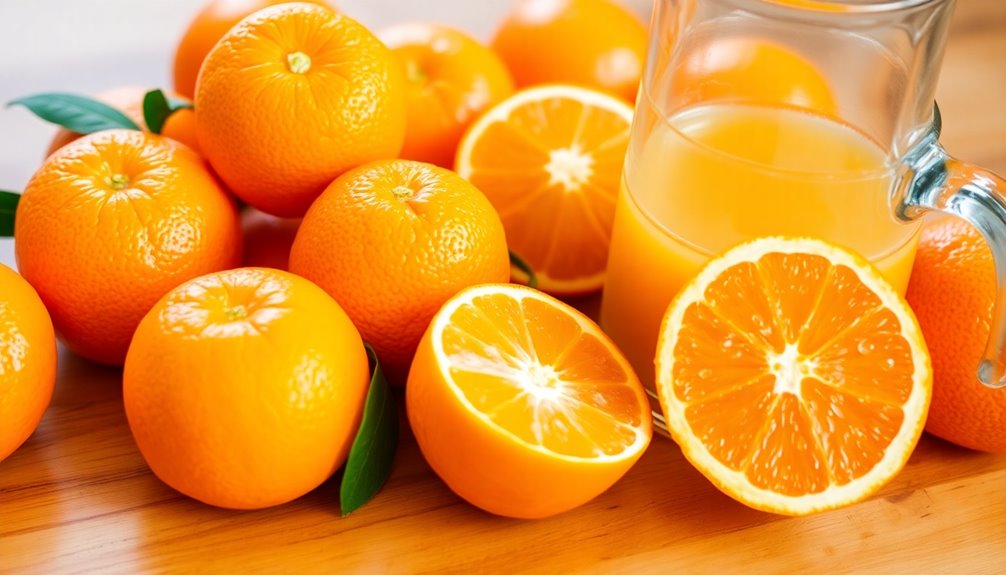
Choosing the right type of orange for juicing can elevate your beverage's flavor and nutritional value.
Valencia oranges are a top choice, bursting with sweetness and high juice content, perfect for commercial use. Navel oranges, seedless and refreshing, can sometimes turn your juice bitter, so keep that in mind. High content of tangy, sweet juice makes them a great option for those who enjoy a flavor-packed drink.
Blood oranges offer a unique tart-sweet profile and are rich in antioxidants. If you're looking for something different, try Cara Cara oranges, which have a sweet, berry-like taste and a beautiful pinkish-red color.
For a fun twist, consider Satsuma oranges, known for their easy peeling and vitamin C richness. Each type brings its own character, enhancing your juicing experience.
Calculating Juice From Multiple Oranges
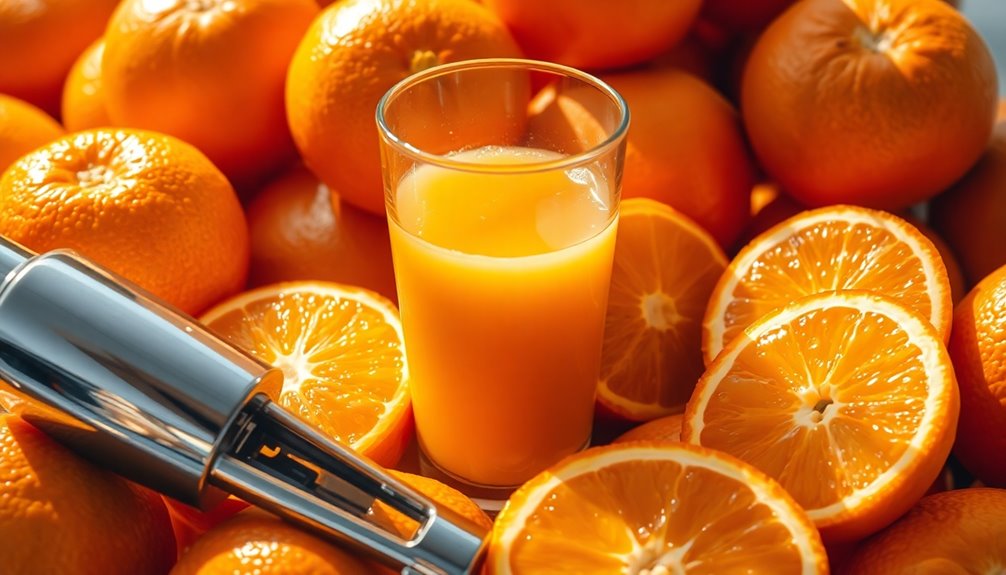
Understanding how to calculate the amount of juice you can extract from multiple oranges is key to maximizing your juicing efforts.
To find your juice yield, use the formula ( JY = JW / FW * 100 ), where JW is the weight of the juice and FW is the weight of the oranges. On average, expect about a 56% yield from your oranges, but remember that size and type can significantly influence this. For instance, three medium-sized oranges typically yield around eight ounces of juice. If you're aiming for a specific amount, adjust the number of oranges accordingly. Keep in mind that juiciness varies, so some varieties may provide better results than others. Additionally, juice yield can be improved by using ripe oranges and high-quality juicers.
Adjusting Recipes Based on Juice Yield
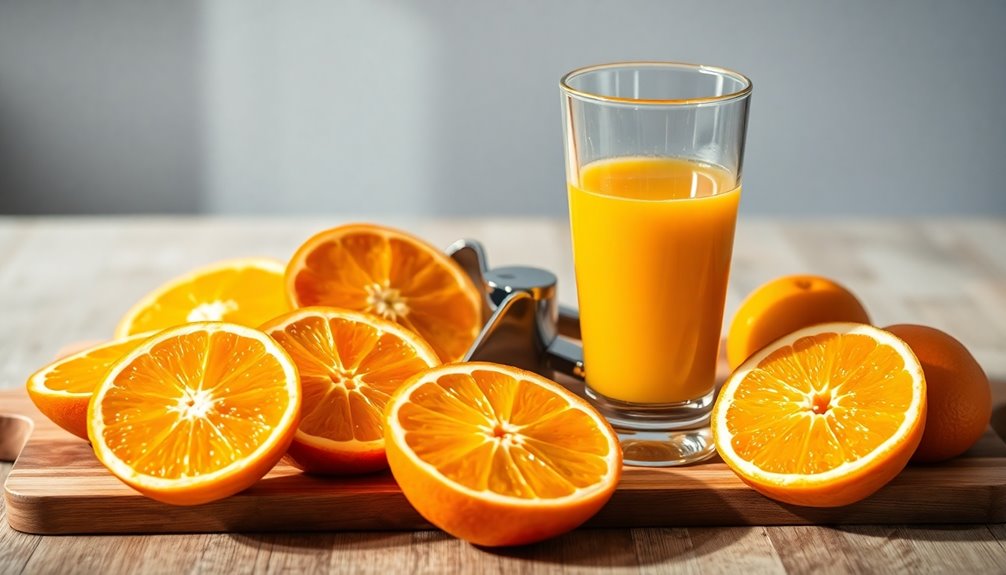
When you're adjusting recipes based on juice yield, it's essential to consider the variability in produce. Different fruits and vegetables provide varying amounts of juice, influenced by their type and water content. To boost your yield, try mixing produce; this can increase juice yield by about 7%. You might also need to adjust acidity by adding citric or malic acid for balance. Remember, flexibility in your recipes is key; tweaking ingredient proportions can help you achieve your desired flavor profile. Use proportional reasoning and ratio calculations to maintain consistency across batches. Additionally, incorporating different produce can greatly enhance your overall juice extraction efficiency. For instance, adding chia seeds can provide additional nutritional benefits while complementing the flavor of your juice.
Tips for Maximizing Juice Production
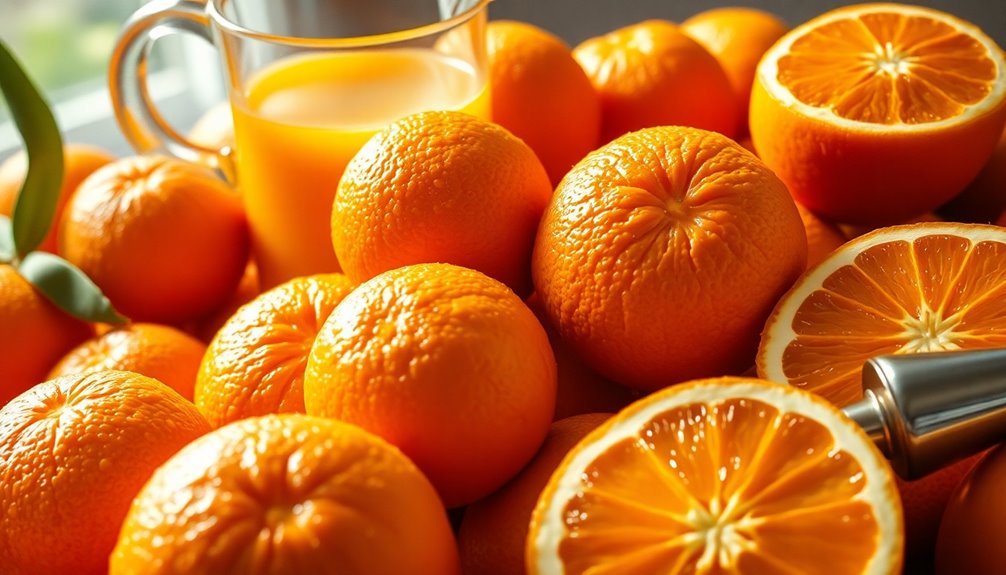
To maximize juice production, focus on selecting high-water content produce, as it yields more juice when pressed. Choose ripe fruits and vegetables to ensure optimal extraction, and don't hesitate to mix different varieties for dynamic flavors and enhanced nutrition. Combining fruits and vegetables can increase your juice yield by about 7%. For better juicing performance, consider using a masticating juicer, which provides higher yields than centrifugal models. Regular maintenance is key, so keep your juicer clean to prevent clogs. Additionally, understanding the water content of different fruits and vegetables can help you select the best options for maximizing yield. Pre-treating hard produce by soaking it in water can also improve juice extraction. Finally, experiment with chopping your produce into smaller pieces, as this can facilitate the juicing process and boost your overall yield.
Practical Applications for Juice Math
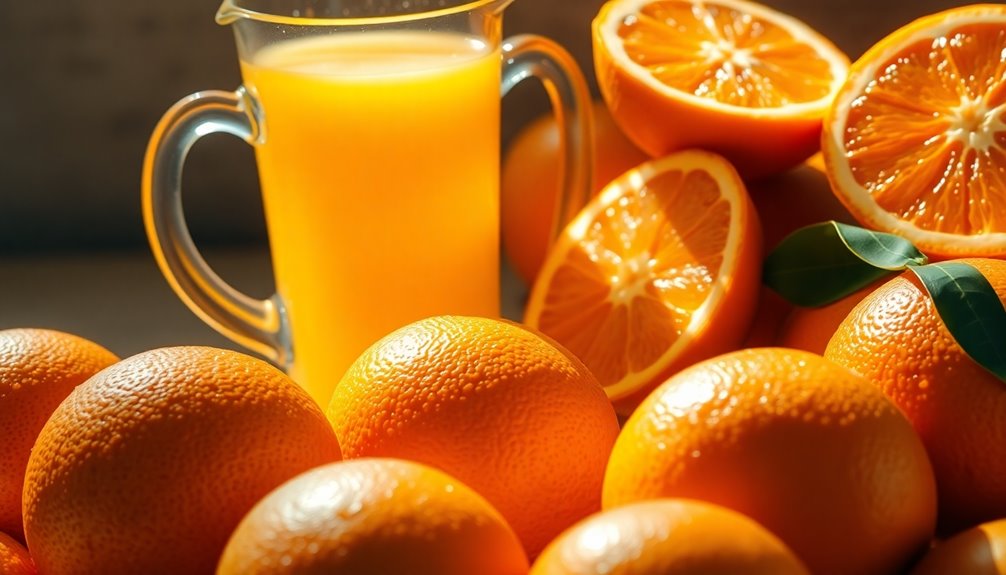
Maximizing juice production isn't just about the ingredients; it also involves applying mathematical concepts to achieve the best results. Understanding concentrate ratios is key. By calculating the right proportion of juice concentrate to water, you can enhance the taste and strength of your juice. This knowledge helps create consistent flavors across different recipes. Additionally, calculating the amount of real fruit juice can ensure you are providing a nutritious product that meets consumer expectations.
In educational settings, the Orange Juice Problem teaches you about proportional reasoning, allowing you to analyze and compare various recipes effectively.
Additionally, you'll learn to evaluate costs by determining the unit cost of orange juice, factoring in added water for concentrate options. These skills are crucial not only for making informed decisions but also for understanding nutrition labeling and ensuring precise measurements in real-world applications.
Frequently Asked Questions
Can I Freeze Orange Juice for Later Use?
Yes, you can freeze orange juice for later use!
It's a great way to preserve its freshness and nutrients. Just pour the juice into well-sealed containers or freezer bags, leaving some space for expansion.
Remember to label them with the date. When you're ready to enjoy it, simply thaw the juice in the fridge.
This method allows you to savor the taste of summer oranges any time you want!
How Long Does Fresh Orange Juice Last in the Fridge?
Imagine pouring a vibrant, sun-kissed glass of freshly squeezed orange juice.
That delicious drink lasts just 2-3 days in your fridge. After that, it starts to lose its freshness and flavor. To enjoy it at its peak, it’s best to consume it within that timeframe. If you’re ever wondering how long grapefruit juice stays fresh, keeping it tightly sealed can help preserve its taste a little longer. However, once it’s past its expiration, you’ll notice a decline in both its aroma and taste, making it less enjoyable to drink.
To keep it tasting great, store it in an airtight container and make sure the fridge stays at a cool 40°F (4°C).
If you want it to last longer, consider freezing it – but remember, the quality might dip a bit.
What Equipment Is Best for Juicing Oranges?
When you're looking for the best equipment for juicing oranges, consider your needs.
For large quantities, the Zulay Professional Heavy Duty Citrus Juicer is ideal, while the Chef'n FreshForce is great for smaller kitchens.
If you prefer electric options, the Breville Citrus Press Pro offers efficiency and ease.
For versatility, the OXO Good Grips 2-in-1 Citrus Juicer is a solid choice.
Choose based on space, quantity, and ease of use to find what's right for you.
Does Orange Juice Lose Nutrients Over Time?
Yes, orange juice does lose nutrients over time.
As you store it, factors like oxidation, light exposure, and temperature can cause significant vitamin C degradation. If you keep the juice in a poorly sealed container or expose it to heat, the nutrient loss accelerates.
To preserve its benefits, drink it soon after opening, store it in airtight containers, and keep it refrigerated. Freezing is also a great option to maintain vitamin C levels.
Can I Mix Different Orange Varieties for Juicing?
Imagine a painter mixing vibrant colors on a palette—each hue brings its unique essence to the canvas.
You can mix different orange varieties for juicing to create a delightful flavor symphony. Valencia oranges offer sweetness, while Navel adds a smooth texture.
Blend in some mandarins for a tangy twist. Combining these fruits not only enhances the taste, but it also boosts nutritional benefits, making your juice as colorful and nourishing as the artist's masterpiece.
Conclusion
In conclusion, understanding how many oranges you need for a glass of juice can really enhance your juicing experience. Did you know that one medium orange typically yields about 1/4 to 1/3 cup of juice? This means you’ll need about three to four oranges for a refreshing glass! By considering the type of oranges and following the tips for maximizing juice production, you can enjoy a delicious, fresh beverage whenever you want. Happy juicing! Additionally, it’s helpful to perform some juice math and orange calculations to ensure you’re always prepared for your juicing needs. Experimenting with different varieties of oranges can also lead to unique flavor profiles, so don’t hesitate to mix and match! With a little practice, you’ll become a pro at juicing, making it easy to whip up a fresh glass whenever the craving strikes.
Cindy thoroughly researches juicing trends, techniques, and recipes to provide readers with practical advice and inspiration. Her writing style is accessible, engaging, and designed to make complex concepts easy to understand. Cindy’s dedication to promoting the advantages of juicing shines through her work, empowering readers to make positive changes in their lives through the simple act of juicing.

